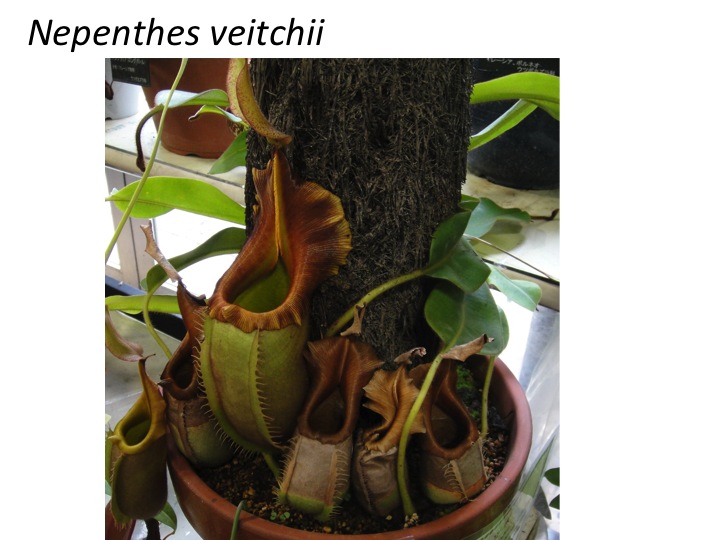ウリ属の巻きひげtendrilは背側の柔組織の中に硬いリグニン化したゼラチン様繊維stiff, lignified gelatinous fiber (g繊維 g-fiber)ができて、g繊維の背側と腹側での非対称な収縮によってひげが巻きつくのではないかと提唱されている(Gerbode et al. 2012)。一方で、g-繊維の収縮では右巻きと左巻きができる仕組みまで説明できていないとして、Wang (2013)らは、チューブリン分子のキラリティーの違いが微小管の配向に影響を与え、その結果、細胞、組織のレベルで巻が生じると考察している。分子レベルでの形態の違いが器官の形態的変化を生じさせうるという例。Nepenthes veichiiの場合は、ウリ科の巻きひげよりも巻き方が緩やかなので違う機構かも。他のウツボカズラ属の葉の蔓は基物に巻き付くけれども、N. veichiiのように太い基物に張り付くようにではなく、細い枝に巻き付く。巻き方も多様である。
どのように巻き付く木を認識しているのかという点も面白い課題かも。
Mechanisms of tendril winding in the Cucurbitaceae have been studies. Gerbode et al. (2012) showed that asymmetric contortion of stiff, lignified gelatinous fiber formed asymmetrically in the tendril tissue should contribute to the winding. On the other hand, Wang et al. (2013) proposed that the helical angle of cellulose fibrils at the subcellular level induces the change in helical morphology of tendril, indicating that the change of molecular structure causes macro morphological changes at the organ level. The winding of Nepenthes veitchii is more moderate than that of the Cucurbitaceae and also of other Nepenthes species. the mechanisms may be different and the diversity of winding is one interesting topics in plant evodevo.
Gerbode, S. J., Puzey, J. R., McCormick, A. G. & Mahadevan, L. How the cucumber tendril coils and overwinds. Science 337, 1087–1091 (2012).
Jian-Shan Wang, Gang Wang, Xi-Qiao Feng, Takayuki Kitamura, Yi-Lan Kang, Shou-Wen Yu & Qing-Hua Qin. Hierarchical chirality transfer in the growth of Towel Gourd tendrils. Scientific Rep. 3102 (2013).

